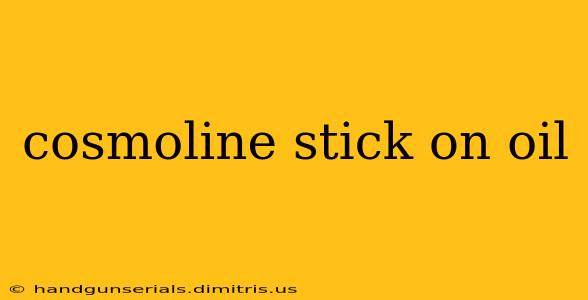Cosmoline. The very name conjures images of greasy, sticky remnants clinging to vintage firearms, antique tools, or perhaps even that dusty, forgotten piece of military surplus equipment in your attic. But what exactly is Cosmoline, and why is it so incredibly sticky? This deep dive explores the composition, uses, and challenges of this unique protective oil.
What is Cosmoline?
Cosmoline is a petroleum-based preservative coating designed to protect metal surfaces from rust, corrosion, and degradation. It's a thick, viscous, and undeniably sticky substance, often dark brown or black in color. Its sticky nature is key to its protective properties; it forms a tenacious barrier that seals out moisture and oxygen, the primary culprits in metal deterioration. While often referred to as an "oil," it's more accurately described as a petrolatum-based grease or paste.
The Composition of Cosmoline
The exact formulation of Cosmoline varies slightly depending on the manufacturer and specific application, but it generally contains a blend of:
- Petroleum Jelly (Petrolatum): This forms the base of Cosmoline, providing its thick consistency and water-repellent properties.
- Mineral Oils: These further enhance the water resistance and contribute to the lubricating qualities.
- Additives: These can include corrosion inhibitors, rust preventatives, and other agents to optimize its protective capabilities. The specific additives often remain proprietary information.
Why is Cosmoline So Sticky?
The stickiness of Cosmoline is a direct result of its high viscosity and the presence of long-chain hydrocarbons within the petrolatum base. These molecules interact strongly with each other, creating a thick, cohesive material that adheres tenaciously to metal surfaces. This stickiness is essential for its protective function; the tighter the coating clings, the more effectively it seals out damaging elements.
The Challenges of Cosmoline's Stickiness
While its stickiness is a crucial aspect of its protective qualities, it also presents challenges:
- Difficult Removal: Cosmoline is notoriously difficult to remove. Simple wiping often proves insufficient, requiring the use of solvents such as mineral spirits, kerosene, or specialized Cosmoline removers.
- Messiness: Its sticky nature makes it messy to handle, potentially staining clothes and skin.
- Residue: Even after thorough cleaning, some residue may remain, particularly in crevices and hard-to-reach areas.
Uses of Cosmoline
Cosmoline's primary use is as a preservative coating for metal objects, particularly those intended for long-term storage or harsh environments. Common applications include:
- Military Surplus: Preserving firearms, ammunition, and other military equipment during storage and transport.
- Antique Restoration: Protecting antique tools, machinery, and other metal artifacts during restoration and storage.
- Industrial Applications: Preserving machinery parts and tools in storage or during transit.
Conclusion: Working With Cosmoline
Cosmoline's stickiness, while a challenge, is a testament to its effectiveness as a protective coating. Understanding its composition and properties allows for better management of its application and removal. Remember to always work in a well-ventilated area and utilize appropriate personal protective equipment (PPE) when handling this substance. While its sticky nature presents difficulties, the enduring protection Cosmoline offers makes it a valuable tool for preserving metallic treasures.

